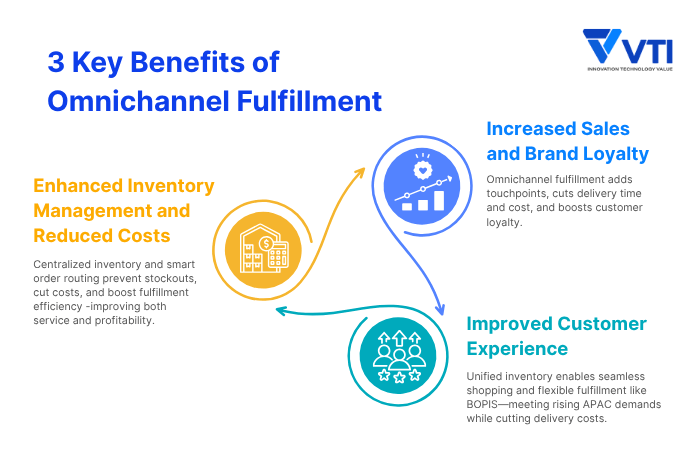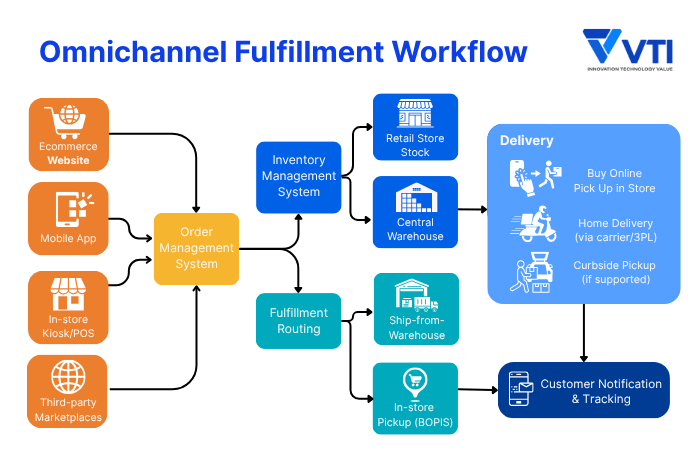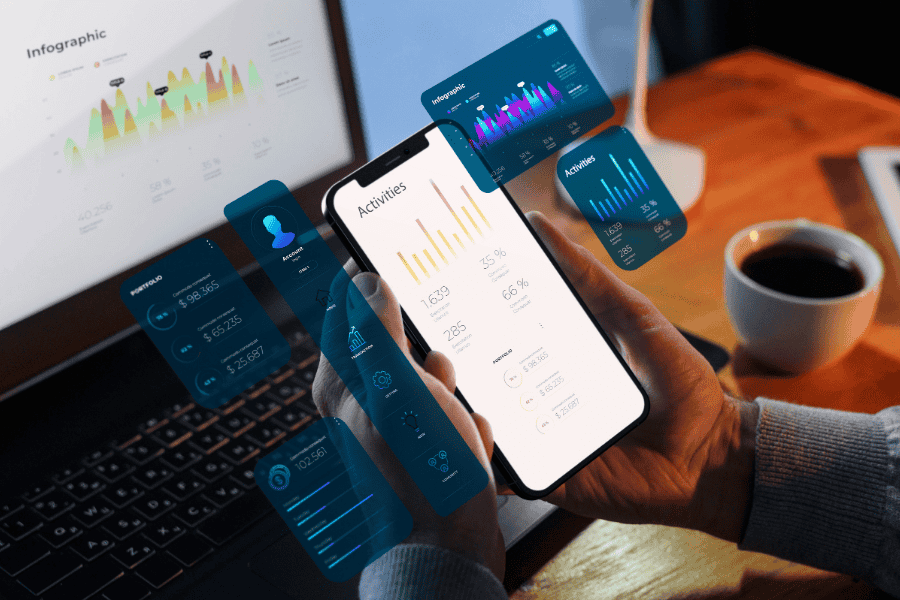With 73% of consumers now shopping across multiple channels before making a purchase, the disconnect between online and offline inventory has become a critical business challenge. Recent retail trends show that 67% of customers abandon their purchase when items appear unavailable online despite being in stock at nearby stores, costing retailers millions in lost sales annually. Omnichannel fulfillment addresses this growing consumer behavior by creating a unified system that connects all sales channels – online stores, physical locations, mobile apps, and marketplaces – into one seamless operation that meets modern shopping expectations.
In this guide, you’ll discover what omnichannel fulfillment really means, explore the tangible benefits it delivers, and learn how leading companies across Asia are using this approach to reduce costs while improving customer satisfaction. We’ll also examine top technology vendors and answer the most common questions decision-makers ask when considering this strategic shift.
What is Omnichannel Fulfillment?
Omnichannel fulfillment represents a strategic approach that unifies inventory and order management across all sales channels – from eCommerce platforms to brick-and-mortar stores, wholesale operations, and online marketplaces. This integration ensures customers experience seamless service from the moment they place an order to the final delivery, regardless of which channel they choose to shop through.
Unlike traditional fulfillment methods that operate in silos, omnichannel fulfillment creates a unified ecosystem where inventory visibility and allocation work in harmony across multiple locations.
The foundation of omnichannel ecommerce fulfillment rests on several interconnected components that work together seamlessly.
Real-time inventory tracking provides complete visibility across all locations, while coordinated order processing ensures efficient fulfillment regardless of channel origin.
Warehouse management systems synchronize with shipping logistics and last-mile delivery services, creating a comprehensive platform that maintains transparency throughout the entire process.
For large businesses and retail managers across Asia, this unified approach eliminates common pain points like overselling and overstocking. The distributed order management system automatically routes orders to the most suitable fulfillment location based on inventory availability, geographical proximity, and cost efficiency. This intelligent allocation reduces fulfillment costs while improving delivery speed – critical factors in competitive markets where customer expectations for fast, reliable service continue to rise.
What are the Benefits of Omnichannel Fulfillment?

Improved Customer Experience Through Unified Channels
A unified inventory system eliminates the frustrating disconnects that customers often encounter when shopping across multiple touchpoints. When customers can seamlessly transition from browsing products online to picking them up in-store, or initiate returns through any preferred channel, the shopping experience becomes genuinely frictionless. This flexibility proves especially valuable in Asia-Pacific markets where consumer expectations for service convenience continue to escalate rapidly.
Moreover, omnichannel fulfillment services enable advanced options like Buy Online, Pick Up In-Store (BOPIS) and curbside pickup, which have become essential differentiators. These flexible fulfillment methods allow retailers to meet diverse customer preferences while reducing last-mile delivery costs – a critical consideration for maintaining competitive pricing in price-sensitive markets.
Increased Sales and Brand Loyalty Through Seamless Transactions
The integration of multiple sales channels through a distributed order management system creates additional touchpoints for customer engagement and conversion. Research consistently shows that customers who interact with brands across multiple channels demonstrate higher lifetime value and purchase frequency compared to single-channel shoppers.
Furthermore, the ability to fulfill orders from the most optimal location – whether that’s a nearby store, regional warehouse, or distribution center – significantly improves delivery speed and reduces shipping costs. This intelligent routing capability, powered by advanced omnichannel fulfillment software, enables retailers to offer same-day or next-day delivery options that build customer loyalty and encourage repeat purchases.
Enhanced Inventory Management and Reduced Costs
Centralized inventory visibility across all channels eliminates the costly problems of overselling and stockouts that plague traditional siloed operations. An order management platform provides real-time data that enables dynamic inventory allocation, ensuring products are available where and when customers need them most.
Additionally, the efficiency gains from streamlined fulfillment processes translate directly into operational cost reductions. By optimizing warehouse utilization, reducing redundant inventory holdings, and minimizing shipping distances through intelligent order routing, businesses can achieve significant improvements in their bottom-line performance while maintaining service quality standards.
How Does Omnichannel Fulfillment Work?
Omnichannel fulfillment operates through a sophisticated ecosystem of integrated technologies and processes that coordinate seamlessly across all sales channels. At its core, this system relies on real-time data synchronization to ensure that inventory, orders, and customer information flow smoothly between online platforms, physical stores, mobile apps, and wholesale operations.

The foundation begins with a centralized order management platform that serves as the command center for all fulfillment activities. When a customer places an order through any channel, the system immediately evaluates multiple factors – including inventory availability, customer location, shipping costs, and delivery timelines – to determine the most optimal fulfillment location. This intelligent routing capability ensures that orders are processed efficiently while minimizing costs and delivery times.
Integration of Various Sales Channels for a Cohesive Approach
Successful omnichannel ecommerce fulfillment requires seamless integration between previously isolated systems. The distributed order management system connects point-of-sale terminals, e-commerce platforms, warehouse management systems, and mobile applications into a unified network that shares data instantaneously.
For example, when a customer in Singapore checks product availability online, they see real-time inventory levels that include stock from nearby stores, regional distribution centers, and supplier warehouses.
This transparency enables retailers to offer flexible fulfillment options such as Buy Online, Pick Up In-Store (BOPIS), ship-from-store, or direct warehouse delivery based on actual availability rather than outdated inventory data.
Moreover, the integration extends beyond order processing to include customer service, returns management, and loyalty programs. A customer who purchases online but needs to return an item can seamlessly do so at any physical location, with the transaction automatically updating across all systems to maintain accurate inventory and customer records.
Utilization of Technology for Real-Time Inventory Tracking
Advanced omnichannel fulfillment software leverages cutting-edge technologies to maintain precise inventory visibility across all locations and channels. RFID tags, barcode scanning, and IoT sensors continuously monitor stock levels, while machine learning algorithms predict demand patterns and optimize inventory allocation.
The unified inventory system provides decision-makers with comprehensive dashboards that display real-time metrics across all fulfillment locations. This visibility enables proactive inventory management, preventing stockouts in high-demand areas while reducing excess inventory in slower-moving locations.
Real-time tracking capabilities also support dynamic pricing strategies and promotional campaigns that can be adjusted based on current inventory levels and demand forecasts.
Collaboration Between Different Departments for Efficiency
Effective omnichannel order fulfillment requires unprecedented coordination between traditionally separate departments. Sales teams, warehouse operations, customer service, and logistics must work together through shared systems and standardized processes to deliver consistent customer experiences.
The technology infrastructure facilitates this collaboration by providing all departments with access to the same real-time data and communication tools. When a warehouse team updates inventory levels, sales associates immediately see the changes on their mobile devices. Similarly, customer service representatives can access complete order histories and inventory information to resolve inquiries quickly and accurately, regardless of which channel the customer used for their original purchase.
#4 Omnichannel Fulfillment Software for Asian Retailers
Selecting the right omnichannel fulfillment software provider requires careful evaluation of vendors that understand the unique complexities of Asian markets. The following analysis examines leading providers that offer robust solutions tailored for large enterprises across Asia.
VTI
VTI is a leading technology solutions provider in the Asia Pacific region, known for delivering scalable, enterprise-grade systems tailored to the needs of the retail and logistics sectors. With a strong presence across the region, VTI has built a solid reputation for its deep understanding of local market dynamics and its ability to support complex operations.
Its core offering is a comprehensive inventory management system that features real-time tracking and seamless integration with existing ERP and WMS platforms. Built for scalability, the solution is highly customizable to fit specific enterprise requirements, making it ideal for enterprises in retail, distribution, or logistics that require advanced inventory management, strong regional support, and seamless integration with existing systems.
VTI’s strengths lie in its regional expertise, robust client support, and a track record of success with major retail brands. Moreover, its focus not only remains on inventory management, but VTI also provides an end-to-end omnichannel solution for a complete digital transformation of your retail.
>> Read more: VTI’s Case Study – Full-cycle development of a Cloud-based Procurement Management System.
SAP
This enterprise-grade solution is built to meet the demands of large-scale, global retail operations. At its core is a powerful distributed order management system designed to handle complex workflows and high transaction volumes with ease. Backed by advanced analytics and deep integration capabilities, it connects seamlessly with virtually any existing business system.
The platform offers strong local implementation support across all key markets, with a well-established footprint in Asia. Known for its robust functionality and real-time reporting, it empowers retailers to manage orders, inventory, and fulfillment across channels with precision and control.
While exceptionally capable, the platform’s complexity and premium pricing may be better suited for large enterprises and multinational retailers with mature IT infrastructure and sufficient resources for implementation and support.
Oracle
Oracle is a global leader in enterprise software, offering a comprehensive suite of cloud-based solutions for businesses looking to optimize operations at scale.
Its order management platform is designed to support complex, high-volume fulfillment processes with built-in AI for smarter, faster decision-making. With elastic scalability and seamless integration across both the Oracle ecosystem and third-party applications, the platform helps enterprises manage demand fluctuations while ensuring regional compliance through localized data centers.
Oracle’s strength lies in its advanced machine learning capabilities for demand forecasting, robust financial integration, and end-to-end omnichannel support.
While powerful, the platform’s depth may pose a challenge for smaller businesses or teams unfamiliar with Oracle tools, often requiring a significant investment in onboarding and training.
Manhattan Associates
Manhattan Associates is a leading provider of supply chain and omnichannel fulfillment solutions, trusted by some of the world’s largest retailers. With a strong focus on retail-specific challenges, its platform is purpose-built to handle complex fulfillment operations across a wide range of formats and volumes.
Renowned for its scalability and deep integration capabilities, Manhattan’s solutions connect seamlessly with leading retail tech stacks and benefit from established partnerships with regional system integrators. Its advanced inventory optimization and fulfillment algorithms enable retailers to deliver a true omnichannel experience with precision and efficiency.
While highly capable, the platform tends to carry a higher cost structure and may require longer implementation timelines – especially for complex enterprise deployments.
| Vendor | Key Features | Best For | Consider If | Pricing |
| VTI | – Real-time inventory tracking – Seamless ERP/WMS integration – Highly customizable – Ecommerce development full-package | Enterprises in Asia-Pacific needing full-stack omnichannel and inventory transformation | You need regional expertise and require scalable, integrated retail/logistics systems | Flexible, project-based pricing |
| SAP | – Distributed order management – Advanced analytics and real-time reporting – Extensive system integration | Large multinational retailers with high-volume, complex operations | You have a strong internal IT team and are ready for a high-cost, high-complexity solution. | Premium license-based + service fees |
| Oracle | – AI-driven order management – Demand forecasting – Omnichannel fulfillment – Tight financial system integration | Global enterprises seeking AI-enhanced | You need deep financial integration and are already in the Oracle ecosystem | Subscription-based SaaS + implementation |
| Manhattan Associates | – Omnichannel fulfillment – Advanced inventory optimization – Deep retail integrations – High scalability and customization | Retail giants needing top-tier omnichannel fulfillment performance | You can afford long implementations and prioritize fulfillment accuracy over speed of deployment | Premium license + services |
FAQs about Omnichannel Fulfillment
As businesses explore omnichannel fulfillment strategies, decision-makers frequently encounter similar questions about implementation and practical applications. These common inquiries address the fundamental concepts that large enterprises need to understand when evaluating unified inventory systems and distributed order management solutions.
Q: What is an example of omnichannel fulfillment?
A: A practical example comes from Japan’s retail sector, where Nitori implements empty-handed shopping that demonstrates effective omnichannel ecommerce fulfillment. Customers browse products in physical stores, scan barcodes using a mobile app, and receive home delivery without carrying purchases. This approach optimizes limited in-store inventory while providing customer convenience.
Similarly, many Southeast Asian retailers enable customers to purchase items online during lunch breaks and collect them from nearby stores after work. The order management platform automatically routes inventory from the most efficient location, whether that’s the pickup store, a nearby warehouse, or another retail location with available stock.
Q: What is the difference between omnichannel and multichannel?
A: Multichannel retail operates separate, independent channels that don’t communicate with each other, creating potential inventory discrepancies and inconsistent customer experiences. Each channel maintains its own inventory, pricing, and customer data, leading to silos that can frustrate customers who expect seamless interactions.
Omnichannel fulfillment, however, integrates all channels through a unified inventory management system that provides real-time visibility across every touchpoint. This integration enables customers to start their journey on one channel and complete it on another without experiencing disconnects or data inconsistencies. The distributed order management system ensures that inventory, customer preferences, and transaction history remain synchronized regardless of which channel customers choose to use.
Final words
Omnichannel fulfillment isn’t just a trend – it’s becoming essential for staying competitive in today’s retail landscape. By unifying your inventory management and order processing across all channels, you can eliminate costly inefficiencies, reduce customer frustration, and create the seamless shopping experiences that drive loyalty and growth.
The technology solutions exist, proven vendors offer robust platforms, and successful implementations across Asia demonstrate real-world results. For large businesses and retail managers, the question isn’t whether to adopt omnichannel fulfillment, but how quickly you can implement it effectively.
Start by evaluating your current systems, identifying your biggest channel disconnects, and exploring vendor solutions that align with your operational scale and regional requirements. At VTI, we offer a comprehensive and customized solution for businesses to efficiently unify inventory and order management across all sales channels, leading to reduced costs and improved customer experience. Ready to streamline your business operations?
![[FREE EBOOK] Strategic Vietnam IT Outsourcing: Optimizing Cost and Workforce Efficiency](https://vti.com.vn/wp-content/uploads/2023/08/cover-mockup_ebook-it-outsourcing-20230331111004-ynxdn-1.png)








